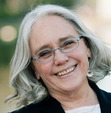Edith Maxwell's Blog, page 58
November 18, 2022
Welcome Guest Author Alex Erickson
Welcome author Alex Erickson, who is here to celebrate the tenth book in his Bookstore Cafe Mystery series, Death by Spiced Chai, which was released by Kensington on October 25th.
Alex writes here about his relationship with coffee, something I have a bit of an interest in myself.

Take it away, Alex!
My Coffee JourneyCoffee and I were not always friends. In fact, I was perfectly content without it. “It’s just dirty water.” I’d said it countless times in my youth. If I wanted something hot to drink, hot chocolate worked just fine.
But then, ever so slowly, my opinion changed.
Back when I was in college, I worked at an Auntie Anne’s in the local mall. I often opened the store, and when I did, I had to choose the coffee for the day. One regular. One decaf. One flavored. It was the flavored one that got me.
I’m not sure how it started. I suppose I was curious. Every time I opened, I made sure the flavored coffee was hazelnut. I couldn’t drink regular, unflavored coffee, nor could I stand French vanilla or any of the other options. Yet, for reasons I have never been able to fathom, hazelnut didn’t have that same “blech” effect on me. I’d make it, and have a small cup in the morning, not because I needed it, but because it was there.
I’ve never needed coffee to stay awake—or wake myself up. Sleep and I don’t get along as it is, so who needs a caffeine jolt when you’re going to be awake anyway?
Yet, sometime after the “hazelnut experiment,” I found myself wanting the comfort of a hot cup of coffee. It was a slow process. I’d go weeks without a coffee. And when I did get one, it might be a latte or cappuccino, something purchased while on the road. Then, ever so slowly, it started to become a habit, and now, I have my morning cup and one evening cup a day.
And still, I don’t feel as if I’m addicted. I have no problem skipping a morning jolt. I don’t need the caffeine to wake up. I don’t get a headache or turn grouchy if I miss out. But there is a comfort to pouring that first cup and savoring its heat that other drinks just can’t match. Even hot tea can’t compare—and I’ve tried.
In the Bookstore Café mystery series, Krissy likes her coffee black with a cookie floating inside it. I’ve been asked if I’ve ever tried it and the answer is a resounding, “No!” I couldn’t imagine drinking anything with chunks floating in it. That includes pulpy orange juice, fruit smoothies, and anything with crushed ice. I don’t want to have to chew my drinks. That’s just . . . ugh!
For my coffee, all I want is a plain coffee—no flavored beans, and that includes the tried and true hazelnut—with pure cane sugar (only a little. I don’t like overly sweet) and hazelnut creamer. Once again, not too much or else I can’t drink it. And, of course, I prefer to grind my own beans.

That’s it. Every now and again, I might have a caramel macchiato from a coffee shop, but we’re talking once every two or three months. And it’s usually when I’m going on a long trip and I’d much rather have a coffee drink than a soda.
Maybe it’s strange that I write about a bookstore café without being a coffee connoisseur or addict.
But I’m going to keep doing it anyway!
Readers: What about you? Do you prefer that morning jolt? Or can you skip coffee for days—maybe weeks—at a time? What about flavors? Take it black and bitter? Or do you prefer your coffee with so much sugar and creamer, it qualifies as candy?
About Death by Spiced ChaiIn a small town like Pine Hills, reputation counts for a lot. And for reasons that Krissy Hancock can’t figure out, someone is trashing hers. Cockroaches in the bookstore’s coffee, spiteful reviews, vandalism—Krissy is being framed for every bit of bad news around. Her boyfriend, local cop Paul Dalton, is on the case, but before they can source the saboteur, Krissy is in the frame for murder, too.
The murder weapon was a teapot full of Krissy’s favorite spiced chai, and all the local gossips are spilling the tea about her supposed involvement. But the real culprit has a grudge that’s been simmering for years. And unless Krissy can uncover the truth before the killer’s rage boils over again, it won’t just be her business in hot water—her life will be on the line too . . .

Alex Erickson is the author of the Bookstore Café and Furever Pets mysteries. His latest book is Death by Spiced Chai. He lives in Ohio with his wife, son, and trio of cats. You can find
him online at https://alexericksonbooks.com/
November 17, 2022
Welcome Back Guest Author Kate Flora and a #giveaway
The Wickeds all know Kate Flora, author, current president of Sisters in Crime New England, early organizer of the New England Crime Bake, and founder of the Maine Crime Writers blog. Today she’s writing about what happens when your sleuth has a baby. (Personally, I can’t imagine. When my protagonist, Julia, is off solving crimes, I’m always worried about who’s feeding the cat.)
Kate is here supporting her eleventh Thea Kozak Mystery, Death Sends a Message, which was released on October 18th. She’s offering one lucky commenter a chance to win a copy below.

Take it away, Kate!
When Your Character has a BabyI always knew this day was coming and I was dreading it. What day, you might ask? The day I finally let my series character have a baby. Why is that such a big deal? Here’s why. When I first designed my Thea Kozak series, my protagonist was single, a grieving widow uninterested in ever taking a chance on love again. I was a bit naïve, despite being an avid mystery reader, and didn’t realize her situation might be a cliché. I wanted her single because it gave her greater mobility in solving crimes. I was also trying to avoid “Cabot Cove Syndrome,” or the problem of having someone in a character’s small orbit die whenever she came to visit. (Would you invite Jessica Fletcher to dinner?) I gave Thea the career of a private school consultant, so she could be called in to help wherever there was a campus crisis.
So far, so good. The first book, Chosen for Death, has Thea investigating her adopted sister’s murder. It gave me the opportunity to introduce her difficult family and backstory, as well as her work with schools. It also dumped her right into the arms of Andre Lemieux, a very attractive Maine state police detective. My plan: It’s a long distance relationship. It’s still Thea’s story. My editor felt otherwise. A lot of her comments on book two were about “pumping up the Andre quotient.”
That on-again, off-again relationship made its way through six books, when an unplanned pregnancy, and a wedding, became inevitable, then delayed when Andre is kidnapped by a patriotic militia group. Thea and Andre wrangled about her headstrong behavior and his over-protective attitude, but she continued with her career. Books seven, eight, and nine saw ups and downs in their lives—including a miscarriage—as she became the go-to person private schools called when serious campus events occurred. Thea took to calling herself “The girl in the white hat” or “Jane Wayne” as she rode into town to sort things out. Since mobility and freedom to pursue investigations were critical to Thea’s job, I didn’t want to put her in a situation where she might put a child at risk. The solution? Don’t let her have a baby.
As an attorney with a background in child protection, I was always attuned to child-related issues in mysteries where the protagonists had children, particular small children. Much as I love his books and his brilliant, lyrical writing, I often joke that if James Lee Burke’s Dave Robicheaux were in my jurisdiction, his careless handling of Alafair’s welfare would have had the state involved. I didn’t want to have to call DHS on my own character. But, as most series writers know, our characters evolve, often in ways we don’t plan. If we write an ensemble cast, their lives also evolve. By book ten, Death Comes Knocking, Thea was again pregnant with the baby she and Andre so badly wanted.

Faced with book eleven, Death Sends a Message, I couldn’t keep that baby from happening any longer. In case you are a crime writer out there contemplating a pregnancy for your character, be warned. It was the hardest writing job of the series. Suddenly, I had a character who had no mobility. Who couldn’t go larking off to interview witnesses. Who was sleep-deprived, facing a daily mountain of laundry, and tied to a tiny person who was totally helpless. She might be willing to put herself in danger, but not her baby. How was I going to make a mystery out of that?
In this latest book, I hoped I’ve solved the problem by having people drop in and gossip. By having on-line searching become a valuable tool. And by having a sleuth who has solved enough crimes to have become wonderfully adept at observation, remembering what she’s seen and heard, and analyzing that. I also struggled to recall baby lore from decades ago, getting updated by the next generation. Among the more amusing pieces of research? Getting a description of using an airplane restroom while heavily pregnant. If your characters have children, how do they manage childcare?
Readers: Do you like reading about sleuths with young children, or do you think they put a drag on a story? One lucky commenter below will win a copy of Death Sends a Message. Answer the question or just say “hi” to be entered to win. We’d love to hear some examples.
About Death Sends a MessageIndependent school consultant Thea Kozak is adjusting to motherhood and enjoying maternity leave, having just purchased a hat for her newborn son, when a hysterical woman gains her attention. The woman, also a new mother, claims her baby has just been kidnapped. Determined not to get involved, Thea flags down a police officer and hands off the problem. She returns home to her husband Andre, intending to enjoy their precious weeks of parental leave.
But Thea’s kindness soon brings trouble to her doorstep when a police officer asks questions about her relationship with Addison Shirley, the mother of the kidnapped child, who claimed Thea was a friend before she disappeared.
The couple’s hopes for a peaceful respite are quickly replaced with a break-in, a stalker, and a private school crisis involving star athletes and sexual assault that only Thea can handle. Thea and Andre wrestle with the lingering mystery and competing priorities while reexamining their future…if they live to face it.
About Kate FloraKate Flora’s fascination with people’s criminal tendencies began in the Maine attorney general’s office. Deadbeat dads, people hurting their kids, and employers’ discrimination aroused her curiosity about human behavior. The author of twenty-four books and many short stories, Flora’s been a finalist for the Edgar, Agatha, Anthony, and Derringer awards. She won the Public Safety Writers Association award for nonfiction and twice won the Maine Literary Award
November 16, 2022
Grateful for Things in 2022

As we come into this time of year when gratitude is everything, we try not to be too materialistic. Nonetheless, I think for each of you Wickeds, something came into your life this year for which you are grateful.
I always think about Mary Chapin Carpenter singing in Passionate Kisses,
“Pens that won’t run out of ink
And cool quiet and time to think
Shouldn’t I have this?”
I think it is the writers’ anthem.
Anyway Wickeds, what object came into your life this year that you are profoundly grateful for?
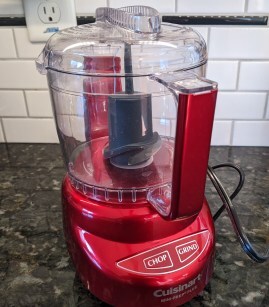
Edith/Maddie: I love that song, Barb. This object has nothing to do with my writing life, except when I’m devising recipes for books or for my twice-monthly Mystery Lovers’ Kitchen blog posts. I recently acquired a new version of my mini-food-processor, a little machine that holds about two cups. I’ve had one for many years, but the motor was grinding, the labels had worn off, and then the lid broke, a lid that has to click in or the machine won’t run. I adore this shiny new red edition, in which I blend up pesto, grind nuts, and make my morning banana-blueberry smoothie, among many other uses.
Liz: My new apartment, hands down. I’m so grateful to be here, near friends and the ocean. It makes me super happy.
Julie: Edith, I love that red! And there does come a point when appliances need to be replaced. And Liz, I’m so glad you’re closer, and that you have your view.
When I thought about what thing I’m grateful for, my mind went all over the place. My sisters and I are clearing out our parents’ house, and I’ve got a few pieces of furniture and some knick knacks that have come to me that make me happy. It would be hard to choose one, but if I had to I’d choose the oak dresser that used to be my grandmother’s, and that my mother used for hats and scarves and seasonal things. I put it next to the window and filled it with my yarn and needlework. Seeing it, and knowing how pleased my grandmother would be that I still practiced the crafts she taught me, and how happy my mother is when I tell her that my cats like to lounge on top and look out the window–that makes it my favorite thing.
Jessie: Julie, I got a little choked up reading your bit! Mine is an espresso maker. My husband stopped drinking caffeine several years ago and we stopped having coffee together because I continued to enjoy my daily jolts. For a variety of reasons we decided to carve out a hot beverage station in our kitchen and we added the machine. Because we make individual cups, and because he loves gadgets, my husband decided to give decaf espresso a try. Now we are enjoying coffee breaks together a couple of times each day. The machine makes great coffee, but it makes even better memories and daily points of connection.
Barb: Jessie, your story about enticing your husband with a gadget puts me in mind of our new thing in 2022, our fully electric car. My husband, Bill, lived his whole life in Massachusetts prior to our move full-time to Maine five years ago. He is that demon on the roads called a Massachusetts driver. For those of you from farther away who don’t know, it means he drives very fast, and with reckless abandon. (If he were writing this, he would tell you what a wonderful driver he is. Never had an accident. Which is true.) He had a big birthday this year, and I mentioned, with trepidation, that his reflexes probably weren’t what they once were and maybe he should slow down. This was met with exactly the response you would expect. However, once the electric car came into our lives, keeping the battery use to a minimum as reflected on the little slide bar on the display behind the steering wheel became a game and he slowed way down. I was reminded once again that you can get some people to do anything by giving them a gadget or a game. Anyway, lo-o-ong way of saying the new thing that came into our lives this year that I am really enjoying is our car.
Sherry: It’s hard to imagine Bill driving anyway other than fast–what is that Massachusetts philosophy — always get ahead of the next car? I love my laptop. It’s lightweight, fast, and portable. I’m always looking things up on it.
Readers: What is new thing came into your life this year for which you are thankful ?
November 15, 2022
Genre-Hopping with Author Elisa M. Speranza and a #giveaway
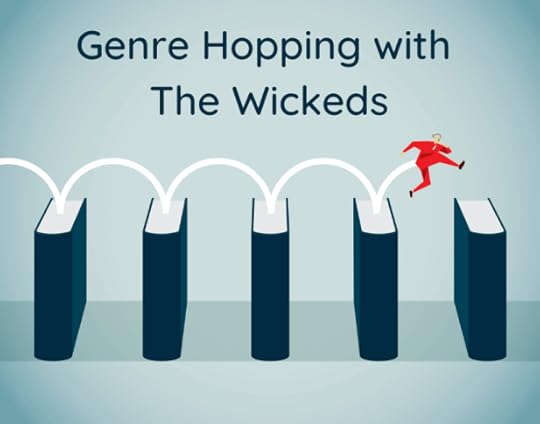
Elisa Speranza, author of The Italian Prisoner, was actually a friend of my husband, Bill’s. They met through politics and government service in Massachusetts. Elisa moved to New Orleans. We moved to Maine. When Bouchercon was in New Orleans in 2016, Elisa was kind enough to send us an email covering all the best places to see and eat, and then to meet us at a concert of NOLA musicians raising funds for musician victims of that year’s flood in Baton Rouge, a thank you to all who helped them after Katrina. It was one of the most memorable things we did there. It turned out that Elisa, too, was a fiction author and a friendship was born.
Elisa is giving away a signed copy of The Italian Prisoner to one lucky commenter below.

The Italian Prisoner is about Italian prisoners of war in New Orleans during World War II and the Sicilian-American community that offered them goodwill and support. From a genre perspective, it is historical fiction. I also think of it a “book club fiction,” because it’s the kind of novel that gives you plenty to think about and discuss after you’ve read it.
Here’s my interview with Elisa.
Barb: I have to admit I knew nothing about WWII POWs in this country until I read your book. I have since learned there were 4000 German POWs in Maine. How did you get interested in this topic?
Elisa: You’re not alone! I’ve talked to so many people—World War II history buffs, Italian Americans, New Orleans folks—unless people had some direct interaction with these prisoners of war, most people have no idea. I stumbled across the story when I met a man named Joe Faroldi, a local chef in New Orleans, back in about 2003. We were swapping stories about growing up in Italian families and he said, “well, my parents were a little different. My father was an Italian prisoner of war during World War II and my Mom was a local Sicilian girl in the French Quarter.” I was floored, and immediately thought, “someone should write a book about this.” It took me a while, but eventually I was that someone.
Barb: Most people associate New Orleans with people with French, Spanish, and Creole backgrounds. What was Little Palermo like in 1943. Is there anything left we can visit today?
Elisa: The migration of Sicilians to south Louisiana in the late 1800s, and subsequently into New Orleans, is another fascinating and little-known aspect of New Orleans culture and history. The lower end of the French Quarter was a thriving ethnic enclave by the early 1940s—the mayor of New Orleans was descended from Sicilian immigrants, local trumpet player and band leader Louis Prima was a star, and there were Italian grocery stores, macaroni factories, bakeries, and restaurants. You can still buy a muffuletta sandwich at Central Grocery, a cannoli at Brocato’s (though it’s moved to the Mid-City neighborhood), or stop into St. Mary’s Italian Church on Chartres Street to light a candle. And Louis’ daughter Lena Prima plays her father’s hits at the Hotel Monteleone’s Carousel Lounge every week.
Barb: There’s a love story at the heart of the book. Can you tell us something about the characters of Rose and Sal?
Elisa: Rose is 18 when the story opens. She’s the youngest daughter of Sicilian immigrants Frank and Filomena Marino. Her older brother Giovanni and sister Laura are off in the war, and Rose is left at home to work in her parents’ grocery store and pine away for a more eventful life. She gets herself a job as a bookkeeper at the Higgins shipyard, where her best friend Marie is a welder. Then the Army brings about 1000 Italian POWs, captured in North Africa, to Jackson Barracks in New Orleans. In real life, the US government asked Italian communities (churches, businesses, civic organizations) to help keep these men entertained and out of trouble—especially after Italy surrendered and switched sides in the war in September of 1943. Rose and Marie join a group of women from the neighborhood who go to visit the POWs—that’s when she first meets Sal, and Marie meets Vincenzo. One thing leads to another, just as it did in real life for at least 10 local women who met their future husbands that way. Sal is handsome, smart, and kind—but is that enough for Rose to give up her dreams of independence?
Barb: Rose is a character on a personal journey throughout the book. Against her parents wishes she goes to work in the Higgins Boat factory. What were Higgins boats, and what effect did working there have on Rose?
Elisa: Dwight Eisenhower called Andrew Higgins “the man who helped us win the war.” Higgins boats are the landing craft you see in so many newsreels and pictures of the landing at Normandy and other WWII battles. They were shallow draft boats originally designed for the bayous of south Louisiana—perfect for landing troops and vehicles directly on the beaches of Europe, North Africa, and the Pacific. Higgins Industries employed over 20,000 people in an integrated workforce in seven New Orleans factories during the war. Like many women at that critical turning point in US history, Rose had her first experience of working outside the home. She loved learning new things, using her smarts, having her own money and a feeling of independence. The women were heavily recruited to fill in for the men, and they rose to the occasion, becoming essential to the remarkable success of the “arsenal of democracy.” Then when the men came back, most women were patted on the head and sent home. Everyone was relieved the war was over, but many women were not so happy to be expected to get back to the kitchen. Then we had the ‘50s, which is a whole different story.
Barb: The research for this book must have been amazing. Tell us about some of the people and sources you found along the way.
Elisa: The research was a blast! I spent a lot of time reading primary sources and learning about the war itself, what life was like on the home front, and the impact on women in particular. Luckily, the National World War II Museum is in New Orleans, and I had access to other great resources like the Historic New Orleans Collection. But the best part was meeting the real families who descended from those Italian POWs and their local Sicilian American sweethearts—including one of the POWs (who’s still alive at 99), Giovanni Distefano, and one of the wives, Marguerite Graffagnini Maranto (we lost her to COVID, sadly, but I got to interview her before the pandemic). The families were very generous with their memories, oral histories, photos, and other memorabilia. Linda DiMarzio Massicot, who’s mother and aunt both married Italian POWs was especially helpful in the research and as an early reader. And most of all, I had help from Sal Serio, Curator of the American Italian Library, who was my guide and touchstone throughout the journey. Sadly, Sal passed away about at age 87 about a month after the book was published. He was like a proud papa, and I’m so glad he lived to see the story out in the world.
Barb: You’re an accomplished writer, but The Italian Prisoner was your first foray into fiction. Will you stick with it? And with historical fiction? What are you working on now?
Elisa: Oh, yes. I’ve got the bug now! I’m working on a spin-off from the first book, which will be from the point of view of Laura, Rose’s sister who’s an Army nurse. In The Italian Prisoner, we only meet Laura through letters she’s writing to Rose from the front. In book #2, it’s 1955, flashing back to her time in the war, where things happened that will have repercussions years later.
Barb: What do you see when you look up from a writing session? Music, yes or no? Morning, afternoon, or night? Tell us something about your writing process.
Elisa: What a great question. A lot of things “count as writing” to me, including research and maybe even just thinking about my characters while I walk through the French Quarter. I tend to write in the afternoon, once I’ve finished with all my procrastination chores. When I look up from a writing session, I see the waning sunlight and birds on a telephone wire through the open skylight in my attic office. I smell the jasmine or the sweet olive from my courtyard below, and may hear a high school marching band practicing, the music from the calliope on the Steamship Natchez down on the Mississippi, the train whistle, or the clip-clop of a mule drawn cart coming up Burgundy Street, just as it might have back in Rose’s day.
Readers: Do you have a connection to the second World War? Did you know there were POWs in the States? Answer below or just say “hi,” to be entered to win a signed copy of The Italian Prisoner.
About The Italian Prisoner1943. New Orleans. Rose Marino lives with her Sicilian immigrant parents and helps in the family grocery store. Her older brother and sister both joined the Army, and Rose prays for their safety as World War II rages overseas. Her parents expect Rose to marry a local boy and start a family. But she secretly dreams of being more like her fiercely independent widowed godmother. Behind her parents’ back, Rose lands a job at the shipyard, where she feels free and important for the first time in her life.
When the parish priest organizes a goodwill mission to visit Italian prisoners of war at a nearby military base, Rose and her vivacious best friend, Marie, join the group. There, Rose falls for Sal, a handsome and intelligent POW. Italy has switched sides in the war, so the POWs are allowed out to socialize, giving Rose and Sal a chance to grow closer. When Rose gets a promotion at work, she must make an agonizing choice: follow a traditional path like Marie or keep working after the war and live on her own terms.
Inspired by little-known historical events and set to a swing-era soundtrack, The Italian Prisoner is an engrossing story of wartime love, family secrets, and a young woman’s struggle to chart her own course at an inflection point in American history.

Elisa M. Speranza (she/her) is the granddaughter of Irish and Italian immigrants, raised Catholic, and educated by nuns. She’s been a writer and book nerd all her life. Her first paid job was in the children’s room of her town’s public library, and she was a journalist early in her career, before spending thirty-plus years in the water and critical infrastructure business. The Italian Prisoner is her first novel.
Ms. Speranza serves as Board Chair for the New Orleans Writers Workshop. A native Bostonian and die-hard member of Red Sox Nation, she is an alumna of Boston College and Harvard’s Kennedy School. She lives with Jon Kardon in New Orleans and Oak Bluffs, Massachusetts.
November 14, 2022
Sneak Peek!
Jessie: Back in New Hampshire after a fun weekend at the Crime Bake!
I hope this post finds you well and tucked up somewhere cozy and comfortable with a stack of great books easily at hand! Autumn is probably my favorite season because it is so perfect for donning wooly socks, pouring a hot beverage, and curling up in a wingback chair with my dog Sam, in my library surrounded by books I consider dear friends!
Since it is autumn, the release date for the seventh Beryl and Edwina Mystery, Murder at a London Finishing School, is still a few months off. Despite that, preparations behind the scenes are well underway! Advance reader copies are being printed, the eBook and hardcover formats are available for preorder and I am delighted to reveal the cover! If you want to be sure to stay up-to-date on releases, behind-the-scenes peeks, and photos of my dog, Sam be sure to sign up for my newsletter!
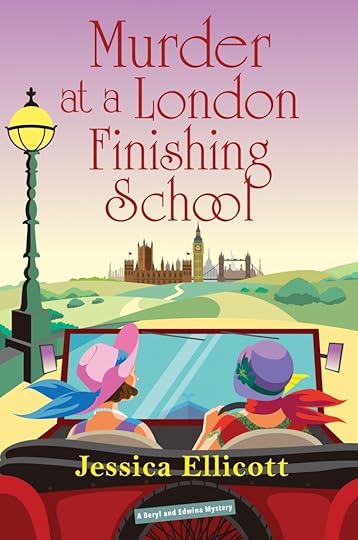
And here’s the copy from the back cover:
American adventuress Beryl Halliwell and prim and proper Brit Edwina Davenport team up once again as enquiry agents to solve a mystery at their alma mater in this historical English village mystery set just after World War I.
Neither Beryl nor Edwina are the least bit interested in attending events at their alma mater, Miss Dupont’s Finishing School. Their lives are very full indeed in the village of Walmsley Parva. However, when a letter arrives from Miss Dupont herself requesting their help in a professional capacity, they reluctantly pack their bags for London.
Upon arrival, they learn from Miss Dupont that her business has seen a steep decline since the days before World War I and that now she is concerned a saboteur is attempting to damage the school’s reputation. Students have reported items missing, damaged possessions, and strange noises in the night. Some of the girls even insist ghostly forces are at play.
Then a former classmate of theirs and mother of a prospective student is found dead on the school grounds. The roll call of suspects is long, and if Beryl and Edwina are to have a ghost of a chance of solving the murder, they can’t rule out the possibility that Miss Dupont herself may have finished off the victim . . .
Readers, which is your favorite season and why?
November 10, 2022
Hollywood Victory Committee from Joyce St. Anthony
Edith/Maddie, here. I’m actually at the New England Crime Bake but happy I can welcome Joyce St. Anthony (aka Joyce Tremel) from wherever I sit. Death on a Deadline, her new Homefront Mystery is out! And she’s giving away a copy to one lucky US commenter.

Here’s the blurb: As World War II rages in Europe and the Pacific, the small town of Progress is doing its part for the soldiers in the field with a war bond drive at the annual county fair. Town gossip Ava Dempsey rumors that Clark Gable will be among the participating stars. Instead of Gable, the headliner is Freddie Harrison, a B-movie star. When Freddie turns up dead in the dunk tank, Irene Ingram, editor-in-chief of The Progress Herald, starts chasing the real headline.
There are plenty of suspects and little evidence. Ava’s sister Angel, who was married to the dead actor, is the most obvious. The couple had argued about his affair with the young starlet Belinda Fox, and Angel was the last person to see Freddie alive. Irene discovers there’s more than one person who might have wanted Freddie dead. As Irene draws on her well-honed reporter’s instincts to find the killer—nothing is what it seems in Progress, and now her own deadline could be right around the corner.
The Hollywood Victory Committee
Thanks for having me back, Wickeds!
In my new release, Death on a Deadline, there’s a war bond drive coming to the town of Progress. It’s scheduled to occur during the annual county fair. The rumor is that Clark Gable will be headlining it, which turns out to be just that—a rumor.
While I took some liberties with the bond drive to fit the story, the Hollywood Victory Committee and the Hollywood Victory Caravan was a real thing.
The committee was started on December 10, 1941, a mere three days after the Japanese bombed Pearl Harbor. The idea was to give stars who weren’t in the military a chance to contribute to the war effort. They would do bond drives, USO shows, and radio shows among other things.

The first chairman of the committee was Clark Gable, who enlisted other actors to join in the effort, including his wife, actress Carole Lombard. In January 1942, she died in a plane crash on her way home from a war bond drive. Later that year, he joined the Army Air Force.
Other committee chairs were James Cagney and George Murphy. Hattie McDaniel became the head of the Negro Division, which seems ludicrous now that even the committee itself was segregated.
In late April and early May 1942, the Hollywood Victory Caravan began a two week trip across the country traveling and performing in various cities and selling war bonds. The first stop was at the White House where they had tea with Eleanor Roosevelt.

Stars included Desi Arnaz, Joan Bennett, Joan Blondell, Charles Boyer, James Cagney, Claudette Colbert, Jerry Colonna, Bing Crosby, Olivia De Havilland, Cary Grant, Charlotte Greenwood, Bob Hope, Frances Langford, Laurel & Hardy, Bert Lahr, Groucho Marx, Frank McHugh, Ray Middleton, Merle Oberon, Pat O’Brien, Eleanor Powell, Rise Stevens. Quite a list! In their two weeks on the road, they managed to net over $700,000, which is the equivalent of over twelve million in today’s dollars!
The performers travelled in fourteen train cars and Bing Crosby had this to say about the trip, “In addition to accomplishing its purpose, I think that everyone connected with it had a barrel of fun, despite the adversities under which we lived and worked. There wasn’t a single squawk about anything or any unpleasantness of any kind. If you could have seen our Hollywood Glamour Girls like Claudette Colbert, Merle Oberon, Joan Bennett and Joan Blondell all jammed together, dressing in the ladies’ rooms of auditoriums, doing it cheerfully and laughing and kidding with each other all the time, you’d know what I mean. If any one of them—or any of the male stars either—had been asked to put up with the inconveniences on a picture, for which they were being highly paid, that they endured with a laugh and for nothing on that trip, they’d have walked out of the picture.”

I can’t imagine the stars of today doing anything like that.
If you’d like to read more about Hollywood and World War II, I suggest Hollywood Victory: The Movies, Stars, and Stories of World War II by Christian Blauvelt. It’s fascinating!
Readers: did you know about the Victory Caravan, or about how many Hollywood stars participated in the war effort? Do you have a fascination with a certain era in history that you just can’t get enough of? Do you enjoy reading fiction that contains real life events? I’ll send a copy to one commenter (US only).
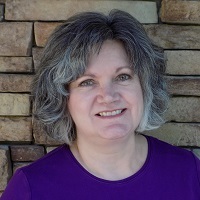
Joyce St. Anthony was a police secretary for ten years and more than once envisioned the demise of certain co-workers, but settled on writing as a way to keep herself out of jail. In addition to the Homefront News Mysteries, she is the author of the Brewing Trouble Mysteries and the upcoming Cider House Mysteries written under her own name, Joyce Tremel. She lives in the beautiful Laurel Highlands of Pennsylvania with her husband.
Buy links: Death on a Deadline (A Homefront News Mystery #2) (Hardcover) | Mystery Lovers Bookshop
Death on a Deadline by Joyce St. Anthony: 9781639101153 | PenguinRandomHouse.com: Books
Social media: www.facebook.com/JoyceTremel, www.twitter.com/JoyceTremel
Plantsing NaNo Style
by Julie, juggling in Somerville
The title of this blog sounds like code, doesn’t it? Let me decode.

NaNoWriMo, NaNo for short, stands for National Novel Writing Month. The goal is to write a 50K draft of a novel by the end of the month. The site has badges are surprisingly effective. And Sisters in Crime is offering four write-ins a day six days a week, twitter sprints and a private group for support for anyone doing NaNo. There are also a couple of webinars planned, include one next week with Hank Phillippi Ryan, “The Magic in the Middle: NaNoWriMo Style”. (You can register here if you’re interested!) I’m the executive director of SinC, so while I’m not running all the write-ins, I’m making sure the ship is running. Thank heaven for wonderful volunteers, but I digress.
Since SinC has started doing NaNo as a group, I’ve been doing NaNo as well. I did it years ago, without much success. But writing together, even virtually, and checking in has kept me on track, and the last two Garden Squad mysteries started during NaNo.
So what’s plantsing? Writers frequently talk about being a plotter or a panster, ie writing by the seat of your pants. Pantsing is also called organic writing. I am a plotter. (I am playing with a new plotting tool called Plottr, which has templates that are very interesting, but I digress again.) Plotting gives me a roadmap for my books, and I usually stick to it for the most part.
I have an idea for a book that I thought of for the first book in a new cozy series, and I decided to write that this NaNo. I plotted it a bit in October, but not up to my normal standards. I decided to tell it from the POV of a niece who lives with her Sherlockian aunt. I started writing on November 1, and then it all went off the rails.
What if, the gremlins in my imagination said, this cute shopping complex on Cape Cod used to be a spy training ground during WWII? What if some of the scenes are from the aunt’s point of view? What if there’s the cozy structure, but with spy stuff thrown in? What if–
The gremlins kept me up, so I started plantsing, which is a mixture of plotting and pantsing. This is not in my comfort zone, but perhaps that’s the point. The beauty of NaNo is that there’s no time to second guess myself. If I want to get that 50K badge, I need to keep writing. The draft will be a mess, but they all are. It may not even work. But then again, it may.
What I do know is that I’m having a blast writing, and that’s a gift to me this November.
Readers, what happens to you when you’re out of your comfort zone? Writers, are any of you doing NaNo this November? I’m cozygal on the site!
November 9, 2022
Grateful for Organizations in 2022

The Wickeds often talk about how grateful we are to Sisters in Crime. We met in the New England chapter for one thing, and all in some way, shape or form, got our start in series publishing because of SinC.
But there are other organizations that shape our lives. Wickeds, tell me about a company, an institution, a church, a school, a non-profit, a membership organization, a network, or any other organized group of people that you are grateful to be associated with, supported by, or just plain on the earth with this year.
Edith/Maddie: Sisters in Crime has certainly shaped my authorial life, for which I am infinitely grateful. Many of you know that my spiritual home is with the Society of Friends. The Amesbury Quaker community has had an enormous influence on my life for thirty-three years. It’s a church, a non-profit dedicated to peace and social justice, and a social network all in one package. It gave my sons a faith community when they were young and helped inspired my seven-book historical Quaker Midwife mysteries.
Sherry: My college sorority. I had no idea on that sunny fall pledge day when I shouted Delta Zeta and ran down the steps to my new sisters how life changing it would be. They were there for the good and bad of life and still are. We laugh together and mourn together and love each other through all of our foibles. I always found it interesting that the other biggest influence in my life would also be an organization about sisterhood (people-hood really).
Liz: My animal rescue crew. Some of the best experiences of my life were when I worked with shelters and rescue groups and helping so many cats. I still have people from that time in my life who I consider some of my best friends, and I’m so grateful for them.
Barb: For 2022, I have to go with the Friends of the Key West Library. I joined this board in 2021 and I have to say throughout the year it’s been tremendous fun to be with a great group of people who work really hard to make good things happen.
Jessie: what a fun range of organizations! I would have to include Novelists, Inc. I joined several years ago and have learned so much since! I love their conference and was so delighted to have had the opportunity to attend in September for the first time since 2019! They support novelists with craft education, business best practices and networking!
Readers: Was there a company, an institution, a church, a school, a non-profit, a membership organization, a network, or any other organized group you are grateful to be associated with, supported by, or just plain on the earth with this year?
November 8, 2022
Where are the Wickeds at the New England Crime Bake 2022?
If you’ve followed the blog for awhile, you know how foundational the New England Crime Bake writers’ conference is for the Wicked Authors. Some of us met there. Some of cemented our friendships while spending time there. All of us moved from hopeful wannabe writer to published author as a part of this community, moving from one side of the panel table to the other, as it were, in a rite of passage.

This year all of us will be at the conference hotel in Dedham, MA. Please come up and say hello when you see us floating by.
Specifically, you can find us in the following places.
Julie and Barb have pre-recorded online sessions for the conference. They will become available before the conference and will stay accessible for conference registrants for 90 days afterward.
Tuesday, October 25, Julie Hennrikus‘s (Julia Henry‘s) online session, entitled, “Starting Your Book: Inspiration, Ideas, Implementation,” is currently available to conference registrants.
Tuesday, November 8, (Today), Barbara Ross‘s online session, entitled, “Story Structure for Crime Fiction,” will be released.
Saturday, November 12, at 9:00 a.m., in-person, Jessie Crockett (Jessica Ellicott) and Edith Maxwell (Maddie Day), will appear on the panel, “Historical Mysteries.”
Saturday, November 12, at 11:45 a.m., Edith Maxwell (Maddie Day) will be signing the anthology, Deadly Nightshade: Best New England Crime Stories, along with the other authors who have stories in the book.
Sherry Harris will be at the conference, in and out of sessions, in the hallway, and the bar. Liz Mugavero (Cate Conte) will also be at the hotel. Please be sure to say hello.
It’s the first time the six of us have been together since covid, so we’re excited. Yes, we’ll be sure to take a photo.
Readers: Are you coming to Crime Bake? If yes, give a shout out as to where and when we can find you!
November 7, 2022
Welcome Author Christine Bagley and a #giveaway
I was a co-editor/co-publisher of the Best New England Crime stories series for six years. The anthology, with stories by authors from each of the six New England states, comes out every year in November, timed for release with the New England Crime Bake mystery writers conference. Editing the anthology was one of the major, formative experiences for me as a writer.
When I was a co-editor, we were thrilled to publish Christine Bagley’s debut story in Best New England Crime Stories 2014: Stone Cold. Now the wheel had turned and Christine is the newest co-editor of the series.
Christine is here today to talk about how her stories are inspired by setting. She’s giving away a copy of the latest anthology, Best New England Crime Stories: Deadly Nightshade, to one lucky commenter below. (Note: Wicked Edith Maxwell/Maddie Day has a story in the collection.)

Take it away, Christine!
Inspired by SettingFor decades, Daphne du Maurier’s name has been synonymous with suspense, aura, and setting. At fourteen, after reading Rebecca, I became a lifelong fan of mystery and suspense inspired by du Maurier’s novels. Years later, I went to Fowey, Cornwall, based solely on her vivid descriptions of the landscape. I walked in her footsteps down a muddy road to Pridmouth Beach, and stared wide-eyed at the hundreds of flapping birds surrounding me, the same images that ignited her short story, The Birds. As I wandered the grounds of Menabilly (the real name of Manderley), I wanted to live her perfect writer’s life; mistress of her own vast estate, a cottage on the ocean in which to write, and wealthy enough to write full time with the help of nannies, nursemaids, cooks, and caretakers. She loved the outdoors and I imagined a solitary figure, walking with stick in hand, interior monologues filling her head as she inhaled the scent of nature. It was then I truly understood why Cornwall had often been her muse.
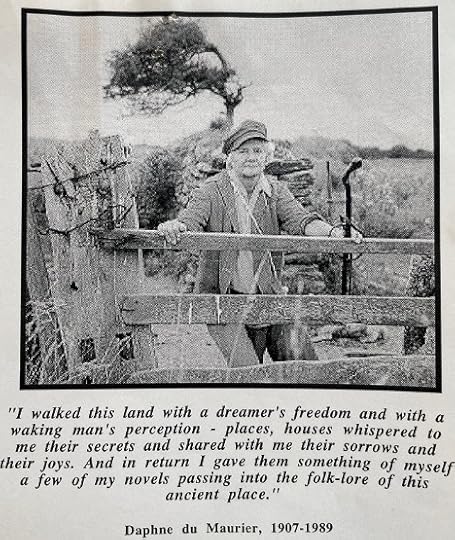
Because of Daphne du Maurier, landscape is still one of the most important elements of my short stories. While studying at Lesley University my thesis seminar was entitled, “Landscape as Character,” and du Maurier was a prime example. Like many of her settings, my stories often include the ocean and stately manors.
On a frigid January day at Marblehead lighthouse, overlooking a deep plunge to the harbor, the idea came to me for On a Winter’s Night. On West Beach in Beverly Farms, walking in front of the enormous mansions that border the shoreline, I imagined someone living in the basement of one of those mansions during the pandemic, and the idea for Valhalla materialized. During a thrilling whale watch in Gloucester, I wrote The Beauport Incident, where Hammond Castle played a pivotal role. In Ireland, the isolation of a rocky moor dating back to the Bronze Age, compelled me to write The Burren. And, after a fascination with the empty stone house across the street, The Madness of Ida Mae was born and became a finalist for the Al Blanchard Short Crime Fiction Award. All of these stories appeared in Best New England Crime Stories’ anthologies.
Recently, at a time when I was unsure what path to take in my writing, I was invited to be a co-editor/co-publisher at Crime Spell Books, publishers of Best New England Crime Stories. I was flattered by the invitation and realized this was a path where I could learn something new in a field that I loved. Best New England Crime Stories holds a special place in my heart and published my very first crime story, The Elevator. Now, I’m on the other side of submissions, reading and editing other writers’ manuscripts. While trying to choose which stories to select for Deadly Nightshade, I was overwhelmed by the talent, cleverness, and originality of the authors who submitted. They were so good it became very difficult to narrow down the final list. I was sorry to tell authors they hadn’t been selected, and thrilled to tell others that they were.
It’s been a real treat to be the new co-editor/co-publisher for Crime Spell Books. I’m especially proud of Deadly Nightshade, a varied and skilled compilation of thought-provoking tales, where each story has something different to engage mystery and crime lovers. Of course, there’s always that one story you find yourself thinking about long after you finish. Well maybe two, no three, okay four, certainly five, wait – six…oh heck they’re all criminally delicious.
Readers: Tell me what your favorite crime story or novel is – and why it’s your favorite, or just say, “hi!” to be entered to win a copy of Deadly Nightshade.
About the bookAfter seven years clean a man finds himself once again in a police cell; a man commits suicide for no apparent reason; the muscle for a mobster reviews his mentor’s life lessons; a longtime widow takes up a life of crime; a librarian proves formidable if occasionally oblivious; a young man escapes the nightmare of a future; a librarian outwits the police; and a killer is trapped—these and other tales of murder, deception, trickery, and rough justice fill the pages of the eagerly awaited anthology, Deadly Nightshade: Best New England Crime Stories 2022 . Now available at Amazon.
About Christine
Christine Bagley has published a number of stories in both crime anthologies and literary journals. She holds an MFA in Creative Writing from Lesley University, and taught writing and presentation skills to foreign national scientists and physicians at the Schepens Eye Research Institute, affiliate of Harvard Medical School. She was also awarded a seat at the 2016 Bread Loaf Writers’ Conference. Currently, Bagley is working on her own collection of short stories entitled, Unleashed.
Learn more about Christine Bagley at www.christinebagley.com

